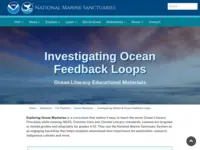Investigating Albedo and Ocean Feedback Loops
https://sanctuaries.noaa.gov/education/teachers/ocean-mysteries/investigating-albedo.html
https://sanctuaries.noaa.gov/education/teachers/ocean-mysteries/investigating-albedo.html
National Oceanic and Atmospheric Administration
In this lesson, students learn about albedo and feedback loops by designing experiments and analyzing diagrams from NOAA.
This learning activity takes one 60 minute class period.
Learn more about Teaching Climate Literacy and Energy Awareness»Grade Level
Online Readiness
Topics
Energy Literacy
This Activity builds on the following concepts of Energy Literacy.
Click a topic below for supporting information, teaching ideas, and sample activities.
Notes From Our Reviewers
The CLEAN collection is hand-picked and rigorously reviewed for scientific accuracy and classroom effectiveness.
Read what our review team had to say about this resource below or learn more about
how CLEAN reviews teaching materials
Teaching Tips | Science | Pedagogy |
Technical Details
Teaching Tips
- Teachers will want to explore outside areas where they may take students to observe temperature differences to ensure there are enough surfaces with varying albedos. Pick a day with sunny weather to do the experiments.
- Gather materials and print worksheets beforehand.
- Consider dividing students into multiple small groups for the activities.
About the Content
- Students investigate the effects of shining light on differently colored materials on temperature. They design experiments to test the important role albedo plays in determining how much radiation is absorbed by a substance. The resource ties this concept into feedback loops and climate change.
- The material is illustrated through real, live data via an interactive image that includes a daily composite of albedo over the course of a week.
- Students are involved in designing and carrying out small group investigations both outdoors and indoors (less controlled/and more controlled environments) to test the effect of warming radiation on different surfaces using the sun/heat lamp.
- This resource draws on numerous solid scientific sources (NOAA, NASA, National Geographic), provides students with the opportunity to design their own experiment, and engages students with data.
- Passed initial science review - expert science review pending.
About the Pedagogy
- Students are engaged in two hands-on experiments, using a set of materials and a worksheet. The resource includes engaging questions for further discussion/inquiry/extension and ways to take action such as the activity book on climate resilience. The lesson includes several short videos and real data to help further understanding.
- Students are offered an introduction to the lesson with background information and key vocabulary, including albedo and positive/negative feedback loops.
- The guide includes specific examples with pictures (white sand beach in FL and sea ice) and images of feedback loops.
- Feedback loops speed up or slow down temperature changes, and are not necessarily good or bad (for example, sea ice melting. This can be a misconception for students, and the images and examples offered in this resource might help students to better understand the material.
- This resource engages students in using scientific data.
See other data-rich activities
Technical Details/Ease of Use
- This resource is easy to use and there is no fee associated with the activity.
- This resource requires thermometers, cups/lids, and heat lamps for the experiment. It also requires access to computers.
- There are two broken links as of the time of review so educators may want to find supplements, although these are supplementary materials. The "Amazing Albedo" lesson and "Feedbacks of Ice and Clouds."
Related URLs These related sites were noted by our reviewers but have not been reviewed by CLEAN
- Climate Change: Arctic sea ice summer minimum
- Found Here is a related activity.








